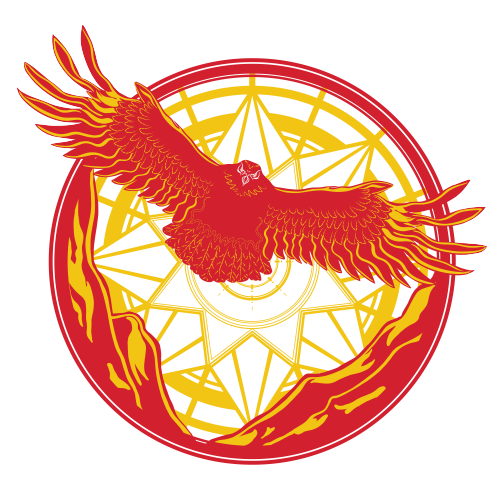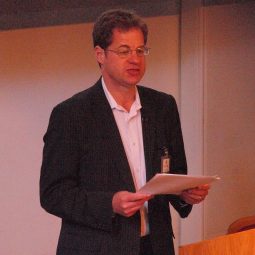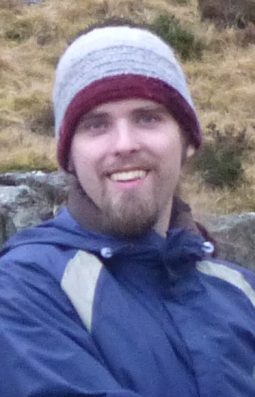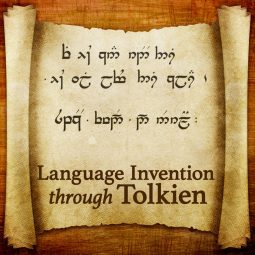INSTRUCTORS:
Looking to purchase an Anytime Audit? Our Lectures are moving! Click HERE to learn all about it.
Mythology is language and language is Mythology
The Mind, The Tongue and The Tale are Coeval (On Fairy-stories, p. 181)I shall express the accusative by a prefix. (The Monsters and the Critics, p. 212)
It must be emphasized that the process of invention was/is a private enterprise undertaken to give pleasure to myself by giving expression to my personal linguistic “aesthetic” and taste and its fluctuations (Tolkien 1967)
“Be careful, friends!” cried Gildor laughing “Speak no secrets! Here is a scholar in the Ancient Tongue. Bilbo was a good master, Hail, Elf-Friend!” He said, bowing to Frodo. (The Fellowship of the Ring, p. 88)
There are arguably two elements of Tolkien’s creative work that readers tend to skip over to “get to the good parts.” One of these is Tolkien’s brilliant poetry – the beauty and excellence of which Dr. Corey Olsen explored in his Tolkien’s Poetry course. Now we would like to invite you to explore the second crucial element of Tolkien’s creative work which is often neglected, or passed over with head scratching puzzlement, by readers – Tolkien’s Invented Languages.
This course will explore language invention through the works of the greatest and most prolific inventors of language for fictional works and world building – J.R.R. Tolkien. In his lifelong work on his legendarium, Tolkien, at both heart and mind a philologist, put language invention at the core of his mythology. Tolkien narrative and para-textual work is infused with his invented names for people, places and items, as well as the use of these invented languages in dialogue, prose and poetry. The interdependence of invented languages and mythological narrative permeates the entire Legendarium Tolkien would work on for over sixty years and is a crucial and consistent element of his world-building.
This course will be taught in three key parts.
In part one, we will set a context for Tolkien’s language invention by exploring the tradition of invented languages which Tolkien was working from, building upon and responding to in his own creative work. This will include the reading and discussion of primary texts and secondary analysis of some of the major invented languages before Tolkien and an exploration of their linguistic, narrative and cultural contexts and, in several cases, what elements of them Tolkien responded to in his language invention.
In the second part of the course, we will study in-depth analysis of Tolkien’s own “nexus” of Elvish and other invented languages by exploring the theory behind Tolkien’s language invention and analyzing the corpus of languages Tolkien created – from pre-Legendarium languages like Nevbosh and Naffarin through the languages Tolkien created coeval and codependent with his Legendarium. Then, we will explore the audience/reader reception of Tolkien’s languages and examine they have been used online and in various media, including the recent Peter Jackson films. We will also discuss and debate the question of whether Tolkien’s languages can be used for practical writing and conversation (as many have tried to do).
In the third part of the course, we will explore the legacy of Tolkien’s language invention by examining several invented languages contemporary with Tolkien and the invented languages that play an integral role in today’s multi-textual narratives of franchises like Star Trek, Star Wars and the HBO series Game of Thrones.
The course will anticipate the publishing in Spring 2016 of a new edition of Tolkien’s foundational talk on language invention, “A Secret Vice,” co-edited by Dimitra Fimi and Andrew Higgins, which Tolkien delivered in the early 1930s. The co-editors will offer several follow-up lectures on the currently unpublished material that will appear in this volume.
No prior knowledge of invented languages is required. The objective of this course is to look at invented languages from both a theoretical and practical point of view. Students will learn about the different phases of Tolkien’s development of Quenya, with a focus on the language’s structure, grammar and morphology. Special attention will be paid to the theory of Tolkien’s language development, as well as the other key invented languages that both proceeded and followed his work.
Course Schedule
This course includes two pre-recorded 90 minute lectures per week and one live 1-hour discussion session as assigned.
Week 1
The Spectrum of Language Invention
- Okrent, pp. 3-17
- Adams, Pp. 1-16
- Various handouts and online sources
Week 2
Spiritual, Philosophic and Auxiliary Language
Guest lecture by Dr. Dimitra Fimi
- Hildegard of Bingen’s Unknown Language: An Edition, Translation, and Discussion – Sarah Higley (selections will be provided)
- Okrent, pp. 21-131
- Adams, pp. 17-48
- “Tolkien and Esperanto” – Arden R. Smith & Patrick Wynne (will be provided)
Week 3
Art-Langs for Fiction Before Tolkien
- Handouts from excerpts from Rogers and Conley & Cain on each of the specific texts and languages as well as online resources.
Week 4
Cultural Context/Language Theories and Movements at the Time Tolkien Invented His Languages
- Guest lecture by Dimitra Fimi on Sound Symbolism and Language Movements – Joyce, Stein, Dada, Zaum
- Selections from Tolkien, Race and Cultural History: From Fairies to Hobbits – Dimitra Fimi (will be provided)
Week 5
Introduction to Tolkien’s Language Invention
Guest lecture by Carl Hostetter
- Tolkien – “A Secret Vice” and “English and Welsh” in The Monsters and the Critics
- “Languages Invented by Tolkien” – Carl Hostetter (will be provided)
- “Invented Languages and Writing Systems” – Arden R. Smith (will be provided)
Week 6
The Phases of Tolkien’s Elvish Language Invention: Common Eldarin and Qenya/Quenya
- “Narqelion and the Early Lexicons: Some Notes on the First Elvish Poem” – Christopher Gilson (will be provided)
Week 7
The Phases of Tolkien’s Elvish Language Invention: Gnomish/Noldorin/Sindarin
- “Gnomish is Sindarin: The Conceptual Evolution of an Elvish Language” – Christopher Gilson (will be provided)
Week 8
The Other Invented Languages in Tolkien’s Legendarium
- “The Lhammas” and “The Etymologies” in Appendixes E and F of The Lord of the Rings – J.R.R. Tolkien
Week 9
Writing Systems of Tolkien’s Languages: Phonetic Representation vs. Alphabets
Sources, inspirations, different types, and how they change
- “Writing Systems” – Arden R. Smith (will be provided)
- Other online resources will be provided
Week 10
Reader and Audience Reception of Tolkien’s Languages
- Guest discussion with Carl Hostetter
- “Tolkienian Linguistics: The First Fifty Years” – Carl Hostetter (will be provided)
- “Elvish as She Is Spoke” – Carl Hostetter (will be provided)
Week 11
The Legacy of Tolkien’s Language Invention
- Adams, pp. 49-75 (Newspeak and Nadstadt)
- Selections from Cain and Conley (Kesh and Islandia)
Week 12
The Language of Tolkien’s Secret Vice – 20th and 21st Century
- Adams, pp. 111-184
- Okrent, pp. 199-end
- Selections from Peterson
- Conlang website
Bonus Session
A Secret Vice, edited by Andrew Higgins and Dimitra Fimi, was released April 7, 2016, in the U.S. This bonus follow-up session features discussion with Higgins and Fimi upon the book’s publication.
Required Texts
The Amazon links are provided for convenience only, and we encourage students to purchase the text wherever they wish.
- In the Land of Invented Languages – Arika Okrent
- From Elvish to Klingon: Exploring Invented Languages – Michael Adams
- The Monsters and the Critics and Other Essays – J.R.R. Tolkien, ed. Christopher Tolkien
- The Lost Road and Other Writings (The History of Middle-earth Volume 5) – J.R.R. Tolkien, ed. Christopher Tolkien
- The Lord of the Rings – J.R.R. Tolkien
Suggested Texts
- Splintered Light: Logos and Language in Tolkien’s World – Verlyn Flieger
- Encyclopedia of Fictional and Fantastic Languages – Tim Conley and Stephen Cain
- The Dictionary of Made Up Languages – Steven Rogers
- Building Imaginary Worlds: The Theory of History of Subcreation – Michael Wolf
- The Art of Language Invention: From Horse Lord to Dark Elves, The Words Behind World-Building – David Peterson
Course History
This course has been offered in the following semesters.
| Semester | Preceptor(s) |
|---|---|
| Spring 2016 | Nelson Goering & Dr. Karl Persson |
Course Artwork
Course artwork was created by Alicia Fox-Lenz.



